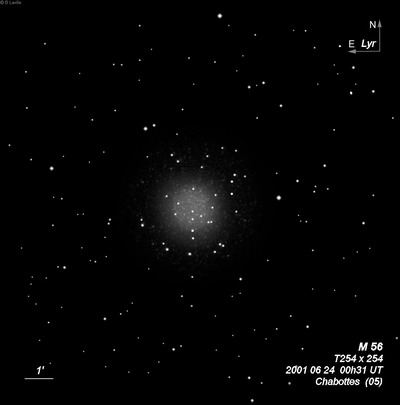
80mm (8/27/87): easily visible at 11x.
Charles Messier discovered M56 = NGC 6779 = h2036 on 19 Jan 1779 and described a "nebula without stars, having little light." Caroline Herschel independently found the cluster on 7 Apr 1783. WH first observed the cluster on 31 May 1783 with his 8-inch and noted it was "all resolved into stars [at high power]." On 17 Jul 1784 (sweep 239), he recorded "a cl of v compressed stars, nearly R, and about 4' in dia, very accumulated in the middle; L, r." JH made a number of observations and on 1 Aug 1829 (sweep 198) recorded a "Fine compressed cluster; R, inclining to a triangular form; bM; stars 12...14m. A fine object, diam 3'." Observing with an 11-inch refractor, Heinrich d'Arrest wrote "a star cluster, which contains a large number of stars, none of which is brighter than 12 to 13th magnitude. With 356x resolved into minute stars." R.J. Mitchell, LdR's assistant on 12 Aug 1855, logged "fine cluster, R, centre much compressed; composed of from 10 to 15 st of 13m and many much fainter ones. A few scattered stars have appearance of rays from the centre."
200/250mm - 8" (10/4/80): very grainy, ragged, few faint stars resolved.
300/350mm - 13.1" (5/26/84): many faint stars and some brighter stars near the west edge.
13.1" (8/16/82): a number of faint stars resolved, particularly at the west edge.
400/500mm - 17.5" (8/27/87): about 30 stars resolved including many mag 15 stars at 280x. Resolution is evident over the entire disc and at the edges of the ill-defined halo. Situated in a rich star field.
600/800mm - 24" (8/12/15): superb view at 564x (10mm ZAO + 2.5x Powermate) in excellent seeing and transparency. This bright globular was highly resolved over the entire large central region and within a straggling, irregular halo that filled the 5' field. Roughly 100 or more stars were resolved, though it was difficult to judge the extent of the halo as it thinned into the density of the surrounding Milky Way star field. The unresolved background glow of the halo was more evident on the south side.
Notes by Steve Gottlieb